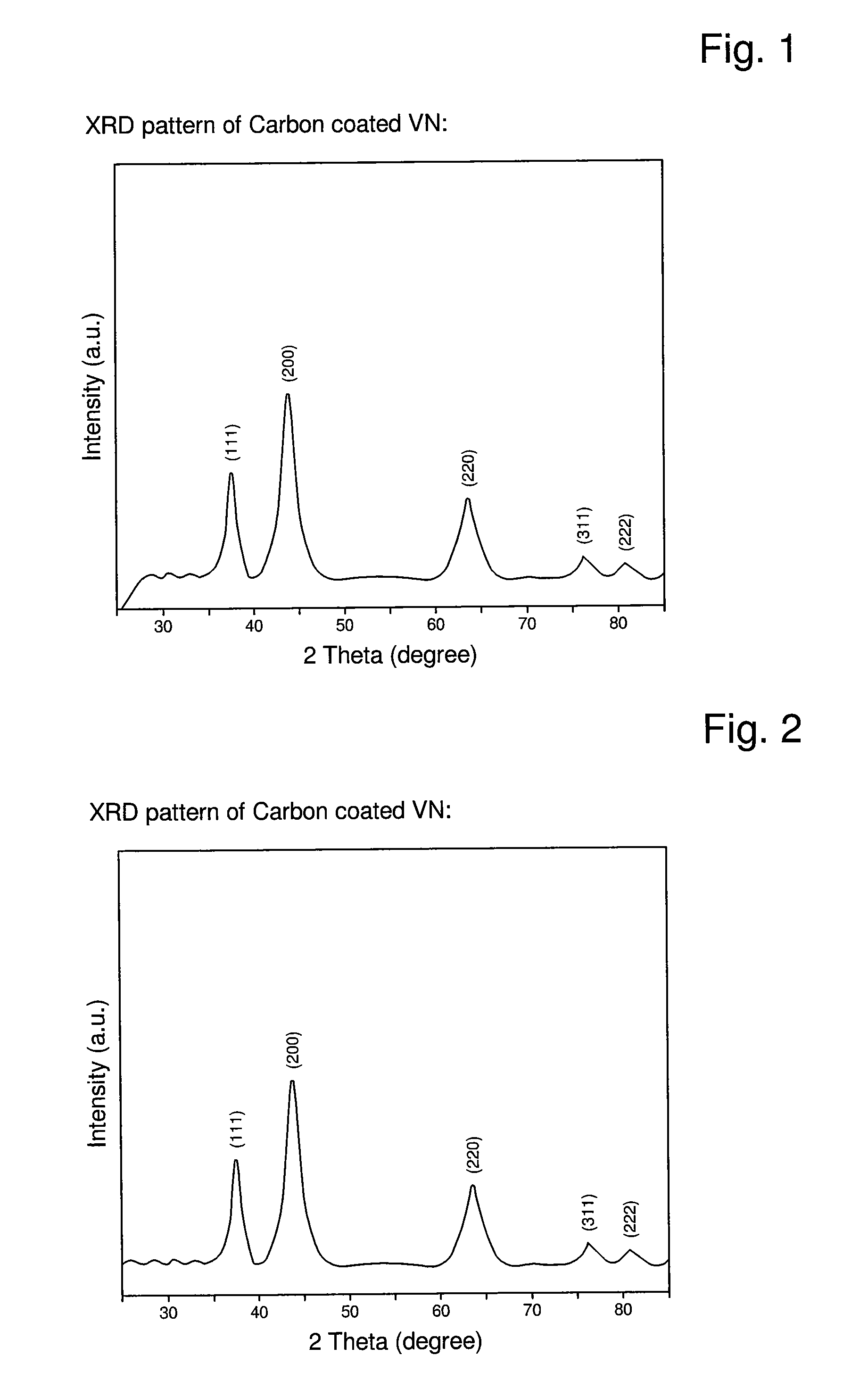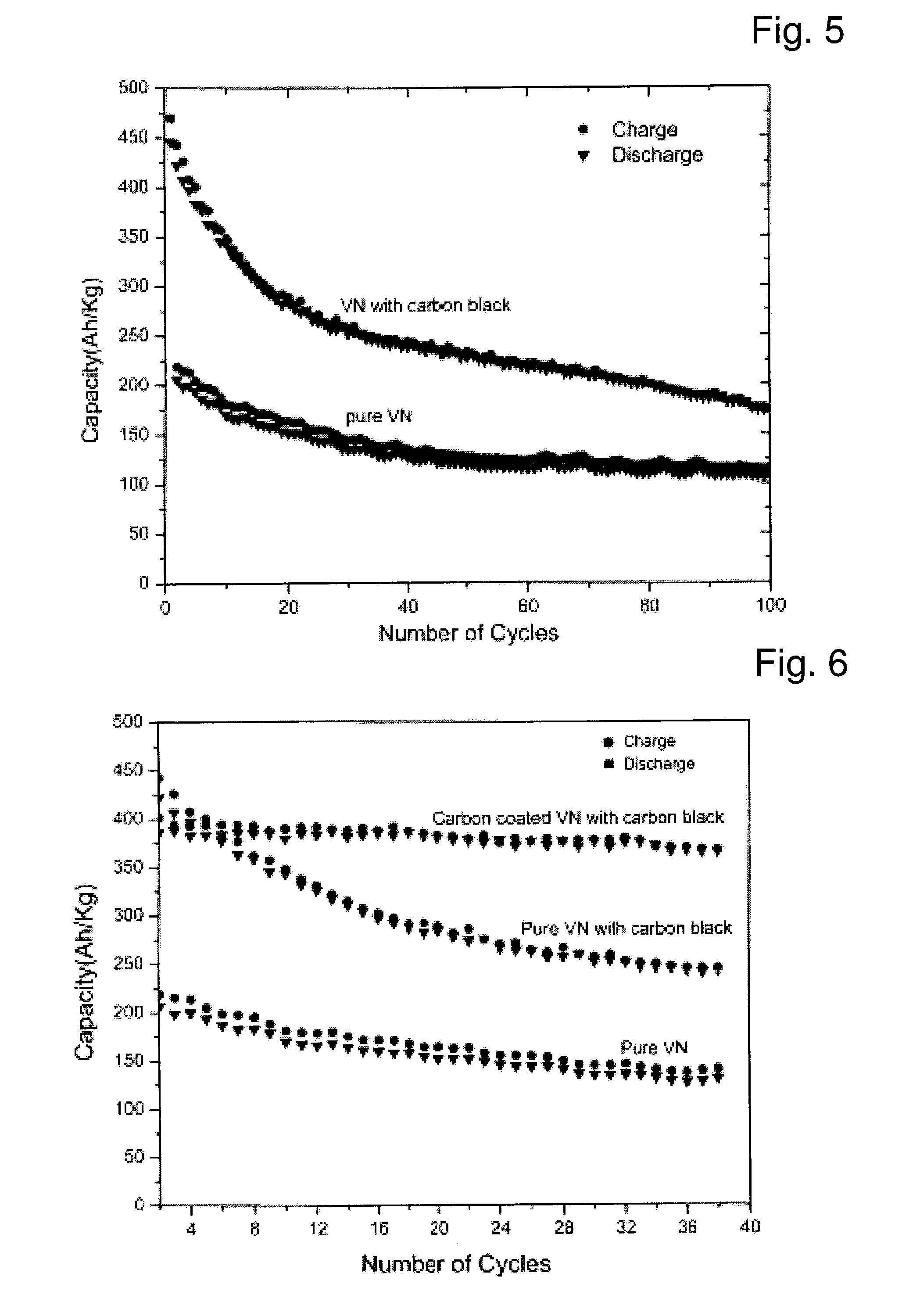Nitride and Carbide Anode Materials
a technology of carbide anode and nitride, which is applied in the manufacture of non-metal conductors, cell components, final products, etc., can solve the problems of low electronic conductivity, initial capacity loss, and failure of aluminium electrodes to maintain structural integrity, and achieve easy synthesis, good interparticular adhesion, and high chemical and environmental stability
- Summary
- Abstract
- Description
- Claims
- Application Information
AI Technical Summary
Benefits of technology
Problems solved by technology
Method used
Image
Examples
example 1
Synthesis of Nanocrystalline Vanadium Nitride
[0057]The synthesis of nanocrystalline vanadium nitride was followed as described by Qian et al. [33]. The product was synthesized employing a reduction-nitridation reaction between vanadium tetrachloride (VCl4) and sodium amide (NaNH4).
[0058]The chemical equation of the reaction is as follows:
VCl4+4NaNH2→VN+4NaCl+N2+NH3+5 / 2 H2 (2)
(one should note that this reaction is not limited to VCl4 but is applicable to other transition metal halides too).
[0059]The synthesis was carried out in a glove box with an inert argon environment. NaNH2 (0.04 mol) was first added into a crucible and then VCl4 (0.01 mol) was dripped slowly into the crucible at room temperature (25° C.). The addition of VCl4 was followed by its very fervent reaction with NaNH2, resulting in the formation of VN. The product was then washed thoroughly with water and ethanol to remove by-products and impurities. Finally, the end product was vacuum dried extensively to remove an...
example 2
Carbon Coating of Vanadium Nitride
[0062]Pure VN was carbon coated using lactose as an organic precursor. A solution of lactose was made in water and then mixed with VN. The amount of lactose used was 15 wt. % with respect to the weight of VN. The mixture was dried and then put in a niobium vial for heating. The vial was gently sealed leaving some vent for the released carbon dioxide and other gases to escape. The whole process was carried out under nitrogen flow to avoid any side reactions. The following temperature program was used for the pyrolysis of lactose: heating from room temperature to 600° C. with a heating rate of 100° C. / hr, keeping a temperature of 600° C. for 5 hours and then cooling to room temperature with a cooling rate of 100° C. / hr.
[0063]FIG. 2 shows the XRD pattern of the carbon coated VN. All the peaks of VN are clearly visible. There has been a little increase in the particle size as can be inferred from the increased sharpness of the peaks. The primary partic...
example 3
Preparation of PEDOT Nanostubs via Reverse Emulsion Directed Synthesis
[0064]The technique of reverse microemulsion in the lines of Sun et al. [38] was employed for the synthesis of PEDOT nanoparticles. Initially 8.5 g (19.12 mmol) of sodium bis(2-ethylhexal) sulfosuccinate (AOT) was dissolved in 70 ml of n-hexane in an ultrasonic bath at 100% power (410 W). Then a mixture of 1.6 g (10.00 mmol) anhydrous FeCl3 in 1 ml distilled water was added dropwise with a Pasteur-pipette. When all the oxidant was added, the resulting solution was taken out of the ultrasonic bath and gently shaken by hand until a milky-yellow precipitate appeared. Then 0.38 ml of ethylenedioxythiophene (EDOT) was added to the emulsion at once. The resulting mixture was then kept at 10° C. in the rotavap for 1 h. Polymerization started when the temperature of the water bath reached about 20° C. After that the temperature of the water bath was maintained at 30° C. for 3 h. Meanwhile the reaction mixture turned gree...
PUM
| Property | Measurement | Unit |
|---|---|---|
| particle sizes | aaaaa | aaaaa |
| particle sizes | aaaaa | aaaaa |
| particle sizes | aaaaa | aaaaa |
Abstract
Description
Claims
Application Information
 Login to View More
Login to View More - R&D
- Intellectual Property
- Life Sciences
- Materials
- Tech Scout
- Unparalleled Data Quality
- Higher Quality Content
- 60% Fewer Hallucinations
Browse by: Latest US Patents, China's latest patents, Technical Efficacy Thesaurus, Application Domain, Technology Topic, Popular Technical Reports.
© 2025 PatSnap. All rights reserved.Legal|Privacy policy|Modern Slavery Act Transparency Statement|Sitemap|About US| Contact US: help@patsnap.com



